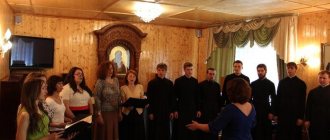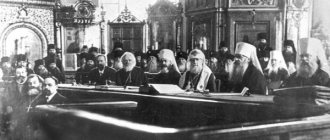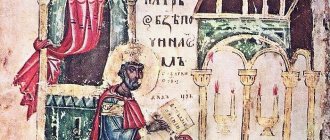| Penza Assumption Cathedral |
Penza and Nizhnelomovsk diocese
of the Penza Metropolis of the Russian Orthodox Church
- Diocesan administration: Russia, 440026, Penza, pl. Sobornaya (Sovetskaya), 1
- Tel., (fax)
- Official site:
- Canonical territory: Penza, Zarechny, Bessonovsky, Gorodishchensky, Kamensky, Mokshansky, Nizhnelomovsky, Penza district, Shemysheysky districts of the Penza region
- Cathedrals: Assumption and Spassky in Penza
- On the map: Yandex.Map, Google map
On October 16, 1799, the independent Saratov and Penza diocese was separated from the Tambov diocese, but, “ due to the lack of convenient premises for bishops and a spiritual consistory in Saratov,
” the first bishop of the new see, Gaiy (Tokaov), achieved the move of the see to Penza and a change on December 4 1803, the names of the diocese became “Penza and Saratov”. On November 3, 1828, the independent Saratov diocese was separated from the Penza diocese.
In 1823, diocesan guardianship for the poor of the clergy was opened, and in 1864, church-parish guardians began to be created. Since 1889, parochial temperance societies began to be created in the diocese.
By the end of the Synodal period, missionary activity was actively carried out in the diocese. In 1904, the Penza Committee of the Orthodox Missionary Society was opened, raising funds for the needs of Orthodox missions in Siberia and the Far East; in 1908, a diocesan missionary council was created to coordinate missionary activities; in 1912, a “foreign” mission was established to work among the non-Russian population and a missionary was appointed, short-term missionary courses began to operate in 1912.
During the Soviet period, the number of Orthodox parishes was reduced to two, and all other church institutions were closed. In the 1920-30s, simultaneously with the Orthodox department, the Penza Renovationist Diocese existed.
The activation of religious life in the diocese began in 1944. On January 29-31, 1991, the Saransk See was separated from the diocese, after which the Penza diocese entered the borders of the Penza region.
On July 26, 2012, the Kuznetsk and Serdobsk dioceses were separated from the Penza diocese, after which the following remained in the Penza diocese: Penza, Zarechny, Bessonovsky, Gorodishchensky, Kamensky, Mokshansky, Nizhnelomovsky, Penza district, Shemysheysky districts of the Penza region. At the same time, the Penza See was determined to be the center of the new Penza Metropolis.
Historical names
- Saratov and Penza (October 16, 1799 - December 4, 1803)
- Penza and Saratov (December 4, 1803 - November 3, 1828)
- Penza and Saranskaya (November 3, 1828 - mentioned October 10, 1978)
- Penza and Kuznetsk (January 29-31, 1991 - July 26, 2012)
- Penza and Nizhnelomovskaya (since July 26, 2012)
Statistics
- 1892 - 1902 persons were in active service, including 22 archpriests, 758 priests, 407 deacons and 715 psalm-readers. Of these, 9 people had an academic education. 18 archpriests, 671 priests (88.52%), 21 deacons (5.16%) and 30 psalm-readers (4.19%) had complete seminary education. Standing apart was ordained in 1892 as a priest to the Edinoverie Church. Poima is a peasant from the schismatics, although he received a home education, but is sufficiently knowledgeable in both the church charter and the Holy Scriptures, and most importantly, well known to the schismatics. The staff included 1 archpriest, 19 priests, 10 deacons and 27 psalm-readers [1].
- beginning V. - more than 780 parishes, 20 monasteries (7 men's; 13 women's), 1010 churches, 404 secondary schools run by the diocesan school council.
- ? OK. beginning V. — 7 hospitals and 11 shelters at churches and monasteries
- 1946 - 29 churches operated in the Penza region.
- January 1, 1958 [2] - 60 registered temples/houses of worship.
- January 1, 2004 - 10 deanery districts, 186 active churches, of which 131 are churches and 55 houses of worship. 32 churches are located in cities, 154 in rural areas. 3 monasteries (2 women’s monasteries (Trinity Monastery in Penza and Trinity Skanov Monastery near Narovchat) and 1 men’s (Kerensky Tikhvinsky in the regional center of Vadinsk with a population of 30 people)). Another convent is in its formation stage - Vladimir-Bogorodsky in the village of Bolshoy Vyas, Luninsky district, which is still functioning as a bishop's metochion. 40 Sunday schools with 800 students.
- November 2011 - 8 monasteries, 107 houses of worship, 16 chapel churches, 213 churches, 7 cathedrals. Operating parishes - 351. Clergy of the diocese - 229 (archpriests - 71; priests - 104; deacons - 16; schema-abbots - 1; abbots - 12; hieromonks - 17; hierodeacons - 6; protodeacons - 2) [3]
- December 2014 - 4 monasteries, a monastic hermitage, 125 active parishes, 3 cathedrals, 88 churches, 29 houses of worship, 132 clergy [3]
History of the diocese
The first Orthodox churches appeared on Penza land at the beginning of the 17th century. Their parishes were part of the Ryazan diocese and personal patriarchal estates. In the middle of the same century, large urban settlements were founded in the Sursky basin - Nizhny Lomov and Penza. At the same time, one of the main diocesan shrines was discovered - the Kazan Icon of the Mother of God.
Assumption Cathedral, Penza
Over the next century, Penza parishes were part of the Kazan, Astrakhan, Suzdal and Tambov dioceses. In 1799, by decree of Emperor Paul I, an independent department was allocated from the Tambov church administration. It united the territories of Saratov and Penza provinces.
Initially, the department of Bishop Gai was supposed to be located in Saratov. But there were no suitable buildings in the city to house the diocesan administration, so the bishop moved his residence to Penza. Since 1803, the local church leader was called the Bishop of Penza and Saratov. After 25 years, the independent Saratov and Tsaritsyn departments emerged from the Penza diocese.
Over the next 100 years, the boundaries of the ecclesiastical and secular administrative units almost completely coincided.
In 1928, the Saransk diocese was separated, while the region located in the north of the modern region remained under the control of the Penza ruler. Church life in the region came to a virtual standstill during the first decades of the Soviet regime. Many archpastors were shot, and most churches were closed.
Important! The revival began in the late 70s. under Archbishop Seraphim (Tikhonov). On his initiative, the revival of churches and Sunday schools began, and active work was carried out on the canonization of local holy primates.
In 2012, the Penza diocese was transformed into a metropolitanate, which included the Penza, Kuznetsk and Serdobsk departments.
Orthodox clergy
ORTHODOX CLERGY - a corporation of professional ministers of religious worship, satisfying religions. the needs of believers through the performance of rituals and actions and preaching Christian doctrine. D. p. is divided into black (monastic, accepting a number of special obligations, including leaving society, celibacy, etc.) and white (living in the world, performing divine services and leading parish communities that have a family).
To Penz. edge D. p. appears as this territory is included in the Rus. the state and country are inhabited here. points and pravosl. temples. Number his was not constant and changed for various reasons. In 1780 the white clergy in Penz. edge was ok. 2200 people In 1894 – 1913 people. (including: 23 archpriests, 771 priests, 402 deacons, 717 psalmists). By 1905 white clergy reaches 2022 people. (including 50 archpriests, 792 priests, 392 deacons, 788 psalmists). To the beginning 1st World War no. The white clergy increases again and amounts to 2068 people in 1914. (including 49 archpriests, 836 priests, 367 deacons, 816 psalmists).
In the 19th century In the diocese, a system for training clergy personnel developed, consisting of 3 theological schools (providing initial theological education) and a theological seminary (cf. class educational institution). According to the beginning 20th century, all archpriests had a full theological education; out of 792 priests special. 659 had education. The level of theological training of the lower ranks of the clergy was significantly lower: out of 392 deacons, only 1 had theological education, and out of 788 psalmists, 34.
D. p. was in Ross. empire one of the privileges. estates. Corporal punishment was not used against its representatives. The clergy were exempt from military service and from all personal taxes. Widows of priests enjoyed the right of personal nobility, and their children enjoyed the right of offspring. honorary citizenship. Orthodox clergy parishes received from the land holdings of parishioners an allotment of at least 33 dessiatines. For example, the clergy of Kazansk-Bogorod. churches with Tarhovo N.-Lomov. u. owned 57 des. arable land and 4 des. wood forest. Each member of the clergy was provided with a house with land for an estate. The land was more often leased by the clergy and less often cultivated by parishioners. D. received one part of his salary from the state. treasury, the other - through the performance of rituals for parishioners. Representatives of the D.P. who left the state received state pension.
Ross laws. The empires entrusted the D.P. with the performance of certain functions of government bodies. The parish clergy registered acts of citizenship. state, announced in the temples naib. important legal acts, orders of the highest secular authorities. This led to the fact that representatives of the D.P. were viewed as official state officials. officials. Hence the negative attitude towards them from part of the population. According to their watering. D.'s preferences were not uniform. Means. part of Penz. The clergy supported the autocracy, and only a small number of clergy sympathized with the social lower classes. Priest F. Pomerantsev was imprisoned for life in the Solovetsky Monastery for supporting the peasants during the Kandiev uprising (1861). The Penz clergy had an ambivalent reaction. diocese to polit. events of 1917. At a meeting of the mountains. The clergy on March 12, 1917 welcomed “the birth of a new free Russia.” Another part of the clergy retained the monarchy. beliefs. After Oct. revolution, the status of the D.P. changed: all class privileges were abolished, the state was abolished. salary (maintenance through voluntary donations from parishioners), the church was nationalized. and monastic lands. The Constitution of 1918 deprived the clergy, as an exploiting class, of voting rights, etc. This caused discontent among some Penz. clergy, pushing some of its representatives to participate in open protests against the Soviets. authorities (Kuchkinsk vol., etc.). In the 20s 20th century There was a split among the D. p. on issues of attitude towards power and reform in the church. Part of the clergy took a loyal position towards the communists. ed. and came up with a program of radical changes in the Orthodox Church. churches (see Renovationism). During the famine in the Volga region (1921–22) main. mass of penz. The clergy reacted favorably to the seizure of the church. property for the needs of the hungry. Conflicts on this basis took place only in Gorodishche, Moksh. and Saran. counties After 1927, in connection with the appeal of the Patriarchal Locum Tenens Metropolitan Sergius, D. p. took a loyal position in relation to the Soviets. authorities, having accepted the idea of watering. neutrality. This did not save him from watering. repressions of the 30s. 20th century
D. p. played a certain role in the organization of the people's system. enlightenment. Before the creation of the state representatives of the education system taught children privately. In the 90s 18th century In Saransk alone, 15 clergy opened private schools. In the beginning. In the 20th century, when the system of church-parochial schools was formed, 26 representatives of the clergy (3 priests, 8 deacons, 15 psalm-readers) were general education teachers in them. subjects, and 357 clergy – teachers of the Law of God. D. p. were also “teachers of the law” in all schools. institutions of the People's Ministry education, which in Penz. diocese would be 500. After 1917, the activities of the D.P. in the field of education were discontinued. It only resumed at the end. 80s 20th century
In 1998 in Penz. The diocese has 116 representatives of the D. p., including 23 archpriests, 85 priests, 1 protodeacon, 7 deacons. Of these, 52 people have spiritual education. (47 – secondary, 5 – higher). Due to the fact that the number of parishes in the diocese has reached 148, some clergy serve not in one, but in two parishes. All clergy work as teachers in Sunday schools at churches. The maintenance of the D. item is carried out through voluntary donations. According to the new pension legislation, clergy who leave the state are paid state. pension.
Lit.: Sacerdotov M. The most ancient educational institutions of the Penza region //PEV. 1894. No. 7; Charter of spiritual consistories. St. Petersburg, 1903; SINGING 1905. No. 9; 1914. No. 14; 1917. No. 6; Penza diocese.
[A. B. Nikonov. ORTHODOX CLERGY / Penza Encyclopedia. M.: Scientific publishing house "Big Russian Encyclopedia", 2001.]
Archpastors
Currently, the head of the Penza and Nizhnelomovsk diocese is His Eminence Seraphim (Domnin), who bears the rank of Metropolitan of Penza and Nizhnelomovsk. He is the 44th diocesan head.
Metropolitan Seraphim heads the Penza diocese
Over its 200th history, the local see was occupied by priests who were later glorified as saints. These include:
- Saint Innocent (March-October 1819);
- Hieromartyr Tikhon (1902-1907);
- Hieromartyr John (1918 - 1921);
- Hieromartyr Theodore (1935-1937).
Bishops
- Gaiy (Takaov) (October 16, 1799 - January 10, 1808)
- Moses (Gemini-Platonov) (March 25, 1808 - May 28, 1811)
- Afanasy (Korchanov) (September 5, 1811 - January 8, 1819)
- St. Innokenty (Smirnov) (March 22 - October 10, 1819)
- Ambrose (Ornatsky) (November 9, 1819 - September 4, 1825)
- Iriney (Nesterovich) (January 31, 1826 - November 3, 1828, November 29, 1828 - July 26, 1830)
- John (Dobrozrakov) (August 17, 1830 - January 19, 1835)
- Ambrose (Morev) (January 19, 1835 - October 15, 1854)
- Varlaam (Uspensky) (December 4, 1854 - October 7, 1862)
- Anthony (Smolin) (November 9, 1862 - August 21, 1868)
- Grigory (Mediolansky) (August 21, 1868 - April 24, 1881)
- Anthony (Nikolaevsky) (May 14, 1881 - April 15, 1889)
- Vasily (Levitov) (April 22, 1889 - July 12, 1890)
- Mitrofan (Nevsky) (July 12, 1890 - November 13, 1893)
- Pavel (Vilchinsky) (November 13, 1893 - June 4, 1902)
- sschmch. Tikhon (Nikanorov) (June 4, 1902 - July 25, 1907)
- Mitrofan (Simashkevich) (July 25, 1907 - January 10, 1915)
- Vladimir (Putyata) (January 10, 1915 - March 1917)
- Feodor (Lebedev) (October 16, 1917 - March 1918) v/u, bishop. Priluksky
- Grigory (Sokolov) (March - April 1918) high school bishop. Krasnoslobodsky
- Leonty (Ustinov) (April 1922 - 1922) v/u
- Peter (Sokolov) (1923) v/u
- Philip (Perov) (December 2, 1923 - 1927) senior, bishop. Nizhne-Lomovsky
- Kirill (Sokolov) (November 1927 - September 6, 1928) v/u, ep. Krasnoslobodsky
- Hieronymus (Zakharov) (1953 - 1954) v/u, ep. Kuibyshevsky
- Barsanuphius (Sudakov) (July 3 - December 28, 2000), high school bishop. Saransk
- Veniamin (Zaritsky) (September 16, 2009 - May 31, 2010) senior, bishop. Lyubertsy
Diocesan departments
The modern activity of the Church is not limited to spiritual service. It covers various spheres of public life. For efficient work, the following departments were organized:
- education and catechesis;
- on working with youth;
- on interaction with the Armed Forces, security forces and Cossacks;
- prison ministry;
- social service and charity;
- on working with pilgrims;
- on conducting missionary activities;
- on combating addictions.
Social institutions
The following social institutions operate in the Penza diocese:
- The Union of Orthodox Women, which provides support to low-income families, single mothers, elderly people and other socially vulnerable segments of the population. Also, members of the organization cooperate with educational institutions at all levels in order to organize educational work based on Orthodox traditions.
The clergy of the metropolis conducts service in a correctional colony - The Union of Orthodox Youth is an organization consisting of young Christians helping parishes in educational, missionary and social activities.
- Orthodox children's shelter "Seraphim", operating at the Assumption Cathedral in the regional center. The center's staff creates a comfortable atmosphere for the physical and spiritual development of children who find themselves in difficult life situations.
Used materials
- Page of the official website of the Russian Orthodox Church:
- Russian Orthodoxy
website page : - Hierarchy of Churches
portal page : - (site unavailable as of 12/17/2011)
[1] Dorzhansky A.I. “History of the Penza diocese. Historical sketch". Penza, 1999. Chapter 14. Mitrofan 1st (Matvey Nevsky), 1890–1893. —
[2] Nathaniel Davis, A Long Walk to Church
, Boulder, San Francisco, Oxford: Westview Press, 1995, 33. Citing Central State Archives, f. 6991s, op. 2, units hr. 1, no. 206, 253.
[3]
Mass media
The diocesan information department operates on the basis of the following media:
- monthly newspaper “Penza Orthodox Interlocutor”;
- monthly magazine “Penza Diocesan Gazette”;
- annual almanac “Penza Chronicler”;
- weekly radio program “World of Orthodoxy”;
- TV program “Questions of Faith”.
Also, detailed information about the activities of the diocese is contained on the official website of the religious organization.
Russian Orthodox Church
Part of the Penza Metropolis
Orthodox churches on the territory of the modern Penza diocese appeared in the first half of the 17th century. Initially they were part of the Ryazan and Moscow Patriarchal dioceses.
In 1682-1699. the western part of the territory belonged to the Tambov diocese. In the 18th century, Penza churches were part of the Synodal Region and the Kazan Diocese, then they came under the jurisdiction of the Astrakhan and Suzdal bishops. In 1758, the Tambov diocese was restored, which included the bulk of the territory of the modern Penza region.
An independent diocese with the seat of the ruling bishop in Penza was formed on October 16/27, 1799 as Saratov and Penza. From December 4, 1803 it was called Penza and Saratov. On November 12, 1828, the independent Saratov diocese was separated from its composition, and the bishops began to be called Penza and Saransk.
In 1928, the independent Saransk diocese was separated from the Penza diocese, and only the southern regions of the former Penza province (north of the modern Penza region) remained under the jurisdiction of the Penza bishops. In 1944-1991. Mordovia was again part of the Penza diocese. Since 1991, the ruling bishop was called Penza and Kuznetsk.
By the decision of the Holy Synod of July 26, 2012 (magazine No. 64), the Kuznetsk and Serdobsk dioceses were separated from the diocese. The Penza diocese is included in the Penza Metropolis. The Synod decided to have the title of “Penza and Nizhnelomovsky” for the ruling bishop.
Diocese today (as of January 2020)
Deanery districts and deaneries
- Spassky City - priest Maxim Zorin
- Petropavlovsk City - Archpriest Vadim Petrushkov
- Nikolsky City - priest Viktor Storozhev
- 1st district of the Penza region - Archpriest Dimitry Kosholkin
- 2nd district of the Penza region - priest Dionisy Solovyov
- Bessonovsky - priest Alexander Ugolkov
- Gorodishchensky - Archpriest Vitaly Yeshchenko
- Kamensky - priest Daniil Boykov
- Mokshansky - Archpriest Mikhail Dergunov
- Nizhnelomovsky - Hieromonk Theodore (Volodin)
- Shemysheysky - Hieromonk Augustine (Zaitsev)
Cathedrals
- Spassky (under construction) Penza, Sovetskaya (formerly Sobornaya) square; tel.; website soborpenza.cerkov.ru rector - Metropolitan Seraphim of Penza and Nizhnelomovsk
- Uspensky Penza, st. Zakharova, 6; tel.; website pnzsobor.ru rector - Archpriest Sergiy Loskutov
Monasteries
men's:
- Nizhnelomovsky Kazansky 442152, Penza region, Nizhnelomovsky district, village. Norovka, st. Tarkhova, 30; tel. (84154) 4-95-36, 4-92-00; website monastir58.ru rector - Metropolitan Seraphim of Penza and Nizhnelomovsk; and about. Viceroy - Hieromonk Theodore (Volodin)
- Penza Spaso-Preobrazhensky 440052, Penza, lane. Spaso-Preobrazhensky, 6A; tel. (8412) 52-35-63 rector - Metropolitan Seraphim of Penza and Nizhnelomovsk; Viceroy - Abbot Sergius (Zaichikov)
women's:
- Penza Troitsky 440600, Penza, st. Kirova, 25 D; tel. (8412) 52-18-20 abbess - abbess Alexandra (Makova)
- Nizhnelomovsky Uspensky 442127, Nizhniy Lomov, st. Sergeeva, 83; tel. (84154) 4-46-44 abbess - abbess Varvara (Trofimova)
Active parishes — 163.
clergy , including 161 priests and 20 deacons.
Mass media
- official website of the Penza diocese: https://Penza-diocese.rf
- Penza Diocesan Gazette (monthly magazine)
- "Penza Orthodox Interlocutor" (monthly newspaper)
- "Penza Chronicler" (annual almanac)
- radio broadcast “World of Orthodoxy” on the regional “Radio Russia”
- “Questions of Faith” (weekly television program on the Soyuz TV channel)
Educational establishments
higher:
- Penza Orthodox Theological Seminary 440023, Penza, st. Perekop, 4; tel.; website https://seminariapenza.ru/; e-mail rector - Metropolitan Seraphim of Penza and Nizhnelomovsk; first vice-rector - Archpriest Nikolai Groshev
average:
- Municipal educational institution gymnasium in the name of St. Innocent of Penza 440028, Penza, st. Kulibina, 10 B; tel., 49-84-09 director - Kalenov Yuri Nikolaevich; confessor - Archpriest Alexy Gorshkov
Educational establishments
Numerous Sunday schools operate on the territory of the Penza department. One of these schools in 1998 was transformed into an Orthodox gymnasium, named in honor of St. Innocent of Penza.
It is located next to the Assumption Cathedral in Penza. There is also an early development school here, where preschool children receive Orthodox education.
Special church education can be obtained at the Penza Theological Seminary.
Churches and temples, monasteries
There are more than 170 churches in the diocesan territory. The largest parishes are the following churches:
- Spassky Cathedral;
- Assumption Cathedral;
- Church of Peter and Fevronia of Murom;
- Church of the Blessed Matrona of Moscow.
Large and small religious buildings are located in all populated areas of the diocese, as well as in social, medical and correctional institutions.
Church of the Holy Apostles Peter and Paul, Penza
Under the jurisdiction of the diocesan head are monastic communities located in the largest populated areas of the diocese. These include the following associations of monks:
- Kazan Monastery in Nizhny Lomov;
- Assumption monastery for women in the same city;
- Transfiguration Monastery in Penza;
- Trinity Convent, located in the regional center.
All monasteries are in deplorable condition. Their gradual restoration is being carried out by the inhabitants and people who come to work in the monasteries for the Glory of the Lord.
Shrines
The main shrine of the diocese are the holy people. The Penza Land Cathedral includes the following primates:
- Saint Innocent of Penza;
- holy confessor John Olenevsky;
- Hieromartyr Theodore (Smirnov);
- Hieromartyr Vasily Smirnov;
- Hieromartyr Gabriel of Arkhangelsk;
- Blessed John Kochetovsky.
Icon of St. Innocent of Penza
Particularly revered by parishioners and pilgrims are two images of the Kazan Mother of God, kept in the monasteries in the cities of Nizhneye Lomovoe and Tver. In addition to the Mother of God icons, the shrines include images of John the Baptist and Saint Paraskeva Friday.








